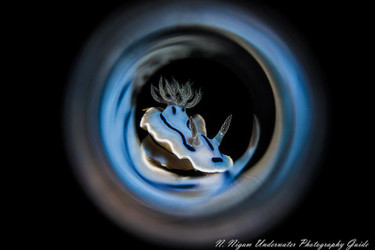Underwater Macro Photography Superstars: Sony A7R IV vs Nikon Z6/Z7
December 16th, 2019
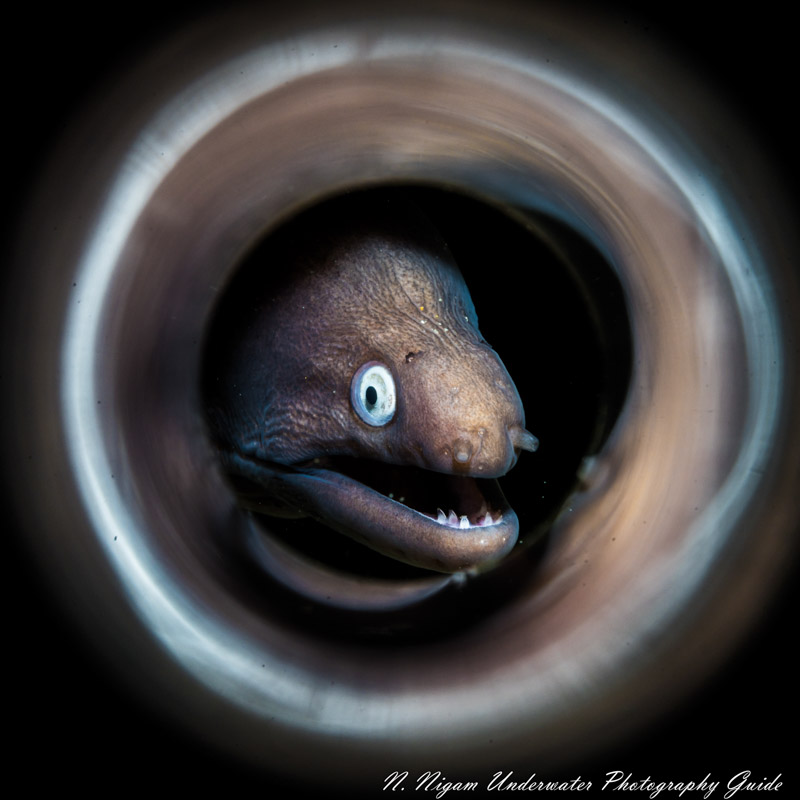
Moray Eel photographed with the Sony A7R IV, Nauticam A7R IV housing, dual Sea & Sea YS-D2J strobes, reefnet fiber optic snoot, and saga magic tube. f/22, 1/250, ISO 200
The last two years have been very exciting for underwater macro photographers. The world has seen huge strides in sensor technology, image stabilization engineering, and focusing systems. Currently the two companies at the forefront of this photographic arms race are Sony and Nikon (sorry Canon – you’ll get there!). Sony tends to unravel groundbreaking new technologies and Nikon follows close behind with equivalent, and sometimes better, answers.
Perhaps the two best full-frame cameras on the market are both mirrorless - the Sony A7R IV and the Nikon Z7. For underwater macro photography, mirrorless cameras present certain benefits that DSLR’s just don’t have. The most apparent benefits are all to do with autofocus. Unlike DSLR’s, mirrorless cameras offer edge-to-edge focusing points available on their sensors. This means your autofocus points aren’t crowded around the center and if you need to focus on the edge for creative effect, you can! There’s less need to pan once in focus. Another benefit is that many mirrorless cameras, particularly Sony’s, have advanced autofocus tracking and eye detect capability. This means you can select your focus point and your camera will track that point whether or not the subject or your camera is moving. Because AF systems in mirrorless cameras are the same when using the EVF or LCD, you can use your LCD underwater with no affect to AF speed. So, if you want to save money on a magnified viewfinder, you don’t need one.
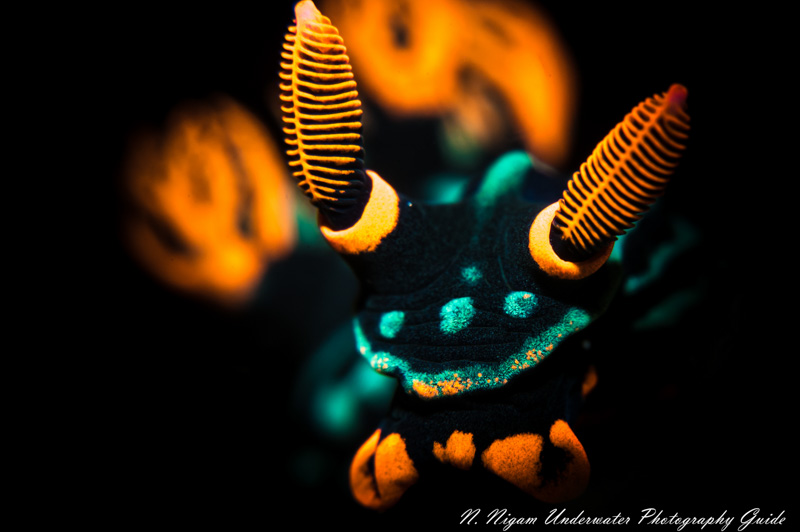
Nembrotha kubaryana nudibranch photographed with the Nikon Z6 camera, Isotta Z6 housing, dual Sea & Sea YS-D2J strobes, reefnet fiber optic snoot. f/29, 1/160, ISO 160
Without a large mirror, mirrorless camera bodies have enough space for in-body image-stabilization systems built around the sensor. These “IBIS” systems allow photographers to shoot longer exposures with less motion blur. This can be especially useful with macro lenses which tend to have long focal lengths and require higher shutter speeds for sharp images.
Finally, the resolution arms race has debuted two heavy hitters. The Sony A7R IV features a record-breaking 61 megapixels full-frame sensor and the Nikon Z7 isn’t far behind 45.7 megapixels. It’s worth mentioning that it’s almost identical little brother, the Nikon Z6 features 24.5 megapixels and superior video quality.
So which camera is better for underwater macro photography – the Sony A7R IV or the Nikon Z6/Z7? I took the Sony A7R IV and the Nikon Z6 to the macro capital of the world, Anilao, Philippines during our Bluewater Travel underwater photography workshop. It couldn’t get more fun than that!
Jellyfish on a blackwater dive photographed with the Sony A7R IV camera, Sony 90mm macro, Nauticam A7R IV housing, dual Sea & Sea YS-D2J strobes. f/22, 1/250, ISO 400
Sony A7R IV vs Nikon Z6/Z7
Resolution and Image Quality
There’s no talking about the Sony A7R IV without talking about its resolution. 61 megapixels on a full frame sensor is revolutionary. In theory it means you can crop a macro photo to your heart’s desire and still have a useable, printable photos. Shooting macro in Anilao, I found this to be true. The detail in the photos I captured was spectacular! I was able to capture average photos of nudibranchs and gobies and turn them into beautiful close up portraits with a little lightroom magic. However, every power does have its limitations. With the A7R IV it’s important to shoot at high shutter speeds in order to maintain maximum sharpness with so many megapixels. While shooting supermacro especially, it could be difficult to get crisp photos unless I shot at high shutter speeds. But when I did, the photos were beautiful and detailed. When it comes to macro photography, most photos are at lower ISOs, so you don’t need to consider the additional noise a high-resolution sensor brings to the table.
The Nikon Z7 is a little less resolution than the A7R IV and the Z6 has a lot less. In all honesty, high resolution sensors are often limited by the optical quality of the glass they sit behind. It’s hard for us to discern a huge difference in the detail of our 100% crops with the Nikon Z7 and the Sony A7R IV. That being said, there are definitely some resolution benefits to having 61 MP over 45.7 MP.
The Nikon Z6 had significantly less resolution than the A7R IV, but it’s certainly a more than adequate performer for most macro photographers, even professionals. Less resolution does yield less noise and motion blur. Was there a discernable difference while editing? The Z6 excelled just a little more in both categories. That being said, there were moments, especially while shooting supermacro photos where I felt a little limited by the Z6’s resolution and was wishing for some of the cropping magic of the A7R IV. The Z6 is not the microscope the A7R IV is. But with good technique, it’s impossible to see the resolution difference with the naked eye on a computer screen between either camera. The real benefit of the A7R IV is in cropping.
*word of warning – uncompressed RAW files from the Sony A7R IV are often between 130 and 150 MB per file – that’s a lot of space!
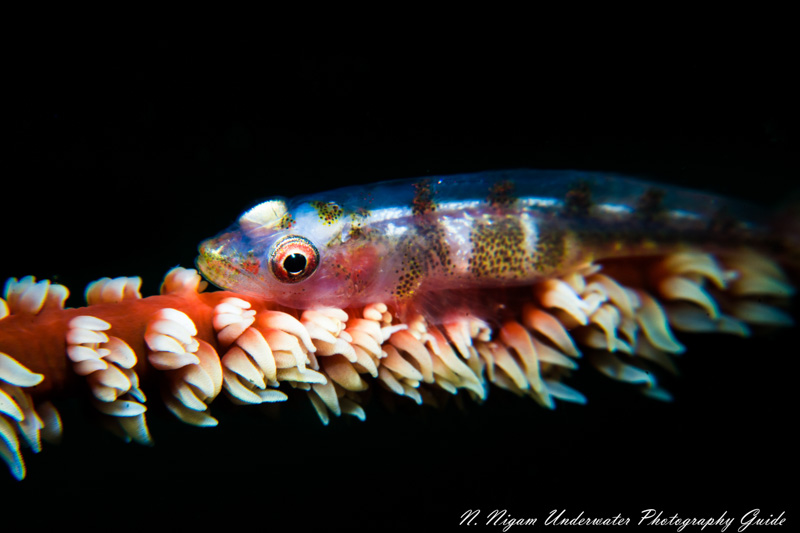
61 megapixels of resolution is perfect for supermacro images with the Sony A7R IV camera, Sony 90mm macro, Nauticam A7R IV housing, dual Sea & Sea YS-D2J strobes. f/22, 1/250, ISO 200
Autofocus
Traditionally, when it came to underwater autofocus Nikon DSLR’s outperformed Sony mirrorless cameras. Now that Nikon has mirrorless cameras, it’s possible to really see which systems have the best AF. The AF speed of the Nikon Z6 and Z7 is quick and snappy, and only a little slower than the Nikon D850. When it first came out, it was better than the A7R III at focusing. But after spending many dives with both the Z6 and the A7R IV, it’s clear that Sony has stepped it up a notch. The A7R IV is better for focusing in macro photography, despite a traditionally slower Sony 90mm macro lens. The key is in the A7R IV’s AF tracking technology. It works and it works very well. I was able to focus on the eyes of clownfish or rhinophores of nudibranchs with the A7R IV and the focus point was stickier than sugar. Anytime the subject moved or the camera, the AF point stuck. If the eye of a fish moved out of the frame and came back in, often the A7R IV would find it. There’s no doubt that the A7R IV has one of the best performing AF systems on the market for underwater macro photography.
I was surprised to be a little disappointed with the Nikon Z6 when compared with the A7R IV. It remains better than the A7R III at autofocusing, but I found it a little trickier than the A7R IV. Don’t get me wrong. The Nikon Z6 has an excellent autofocus system. But I found that it was slightly slower to focus in low light and it’s auto focus tracking does not perform nearly as well as the A7R IV. I often found myself switching back to single AF on the Nikon Z6 and I almost never did with the A7R IV. But did I miss more shots with the Z6 than the A7R IV? Not really. That’s because the Nikon 105mm macro lens that I was shooting tended to be optically sharper than the Sony 90mm macro – especially in super macro situations.
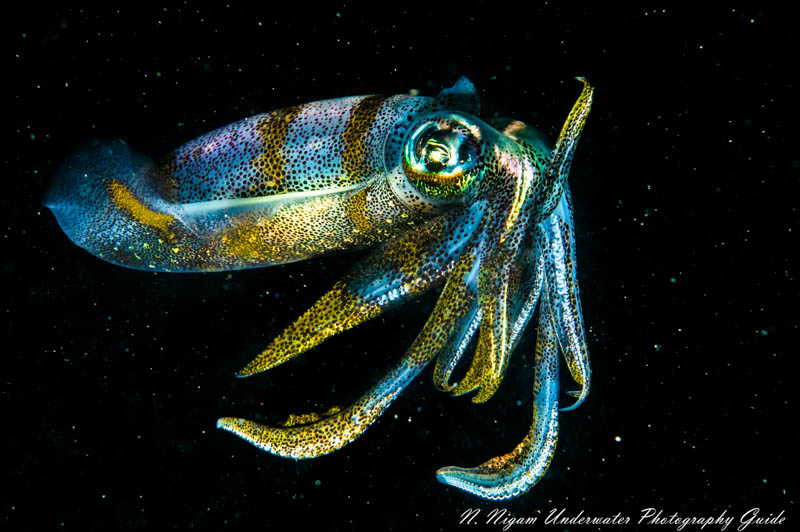
The AF with the Nikon Z6 was quick enough to capture this fast squid photographed with the Nikon Z6 camera, Nikon 105mm macro, Isotta Z6 housing, dual Sea & Sea YS-D2J strobes. f/22, 1/160, ISO 160
Lens Options
For macro photography, Nikon tends to have better lens options than Sony. In Anilao I shot the Nikon 105mm macro with the Nikon Z6 and the Sony 90mm macro with the Sony A7R IV. Nikon also offers a 60mm macro lens and Sony offers a 50mm macro lens. The optical quality of both the Nikon 105mm and the Sony 90mm is professional and the top-of-the line. I personally prefer the Nikon 105mm because of the optical quality of the bokeh. The Sony 90mm tends to blur out backgrounds with less geometric patterns than the Nikon 105mm. I could see this especially in the gills of my nudi photographs. However, the most important benefit of the Nikon 105mm macro is that you can make the aperture of the lens smaller. The Nikon 105 can reach an f/number of f/32 – granted that’s not the sharpest aperture on the lens due to aperture diffraction. However, the Sony 90mm can only reach f/22. I found myself frequently wanting a smaller aperture and more depth of field for super macro images – especially during nudibranch headshots.
*F mount lenses work seamlessly with the Nikon FTZ adapter, so there’s no worry when it comes to using F mount glass with the Z6 or Z7
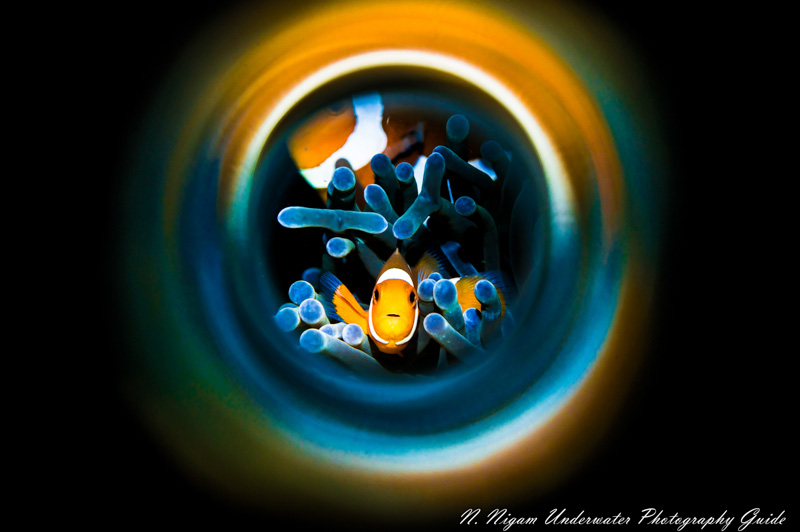
Anemonefish photographed with the Nikon Z6 camera, Nikon 105mm macro, Isotta Z6 housing, dual Sea & Sea YS-D2J strobes, reefnet fiber optic snoot, Saga magic tube. f/16, 1/200, ISO 160
Final Verdict?
In all honesty, when I look at my photos from Anilao, I have to check the meta data to see what camera I shot them with. That being said, each camera has its benefits that appeal to certain users. If you’re looking for the highest resolution and want to print huge photos – the A7R IV is the clear winner. If crops is all you care about I feel that the A7R IV and Z7 are close to a tie with the A7R IV. If you want to save a little money and get an all-around great professional full-frame system, the Z6 could be the way to go. If you need to capture quick moving macro subjects and you pixel-peep at fish eyes, then you might want the AF tracking of the A7R IV. What’s most important to me is the glass. If the optical quality of the lenses are superb, your images will be superb. Though I personally prefer Nikon lenses, both companies make lenses with beautiful optical quality. The good news is that no matter what camera you get, both systems can produce images that will make even the worst of pixel-peepers happy.
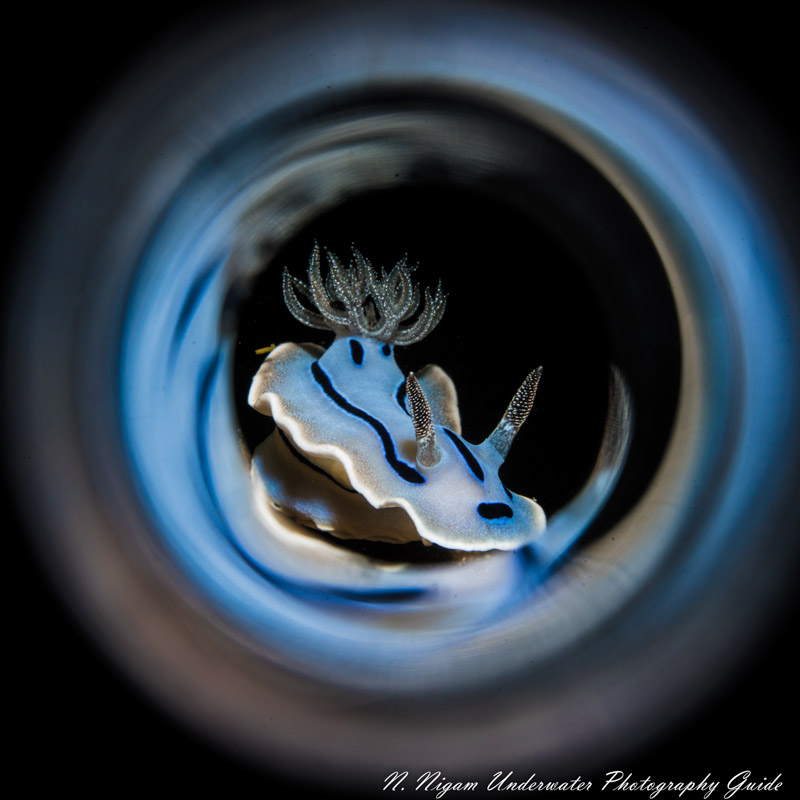
Which camera was this with? Hint: I could blow this photo up to the size of a wall.
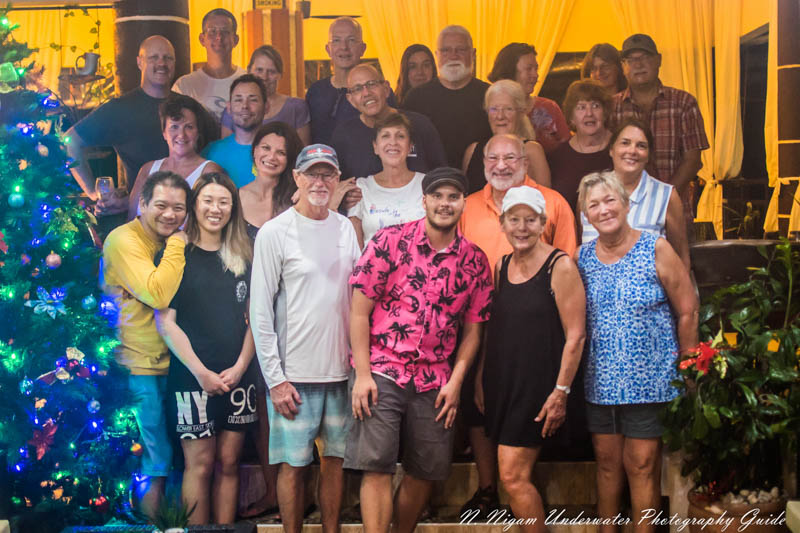
A happy group at the end of an eventful Bluewater Travel workshop!

